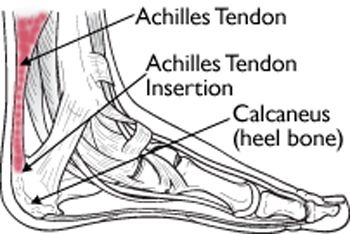Well, let’s start with the name itself – the “Achilles” tendon. It’s named after the Greek hero Achilles, who was a pretty badass warrior but also had a major weakness in his heel.
Talk about irony! But hey, even heroes have their vulnerabilities, right? After all, they are humans too.
It kind of makes me wonder how can a tendon be named after a real-life hero.
Oh, it’s a real showstopper – the largest and strongest tendon in the human body. You could say it is one the most resilient hero of tendons – powerful, commanding, and always ready to perform.
But despite its strength, the Achilles tendon has had its share of emotional moments.
Just think about it. This tendon is the one that supports your ankle and foot.
So it is literally like the brave old king who has to take the entire load of the country on his bare shoulders.
Just think of all the athletes who have suffered from Achilles tendonitis or ruptures – it can be a painful and frustrating experience.
And yet, these same athletes often have a fierce determination to get back on their feet and keep pushing themselves to their limits.
That kind of resilience is pretty sexy if you ask me. More like being a Macho.
And let’s not forget the role the Achilles tendon plays in movement and biomechanics.
It’s a crucial part of the complex machinery that allows us to walk, run, jump, and dance (yes, said dance – tendons can be sexy too, you know!). So, let’s give a little love to our Achilles tendons – they may not be the most glamorous part of our bodies, but they sure do a lot of heavy lifting.. continue reading by clicking on the link below.
What are the symptoms of Achilles Tendon ( Achilles Tendonitis)
That is correct. Achilles tendonitis is a condition characterized by inflammation of the Achilles tendon, which is the largest tendon in the body, connecting the calf muscles to the heel bone. The symptoms of Achilles tendonitis can include:
- Pain in the heel and along the length of the tendon when walking or running.
It’s like the Heel and the tendons going for Couples therapy because they just couldn’t stop fighting. Thus causing inflammation in the bargain called Achilles Tendons.
2. Pain and stiffness in the area in the morning.
Imagine a metal robot without its robotic beauty and the squeaky sound it emits while moving. That is exactly how your tendons feel when it’s inflamed.
3. Pain in the Achilles tendon when touched or moved.
Imagine a celebrity buying fish in a market and someone touches them by mistake what an uproar that scene would be? Exactly like that when your ankles are injured you cannot touch it because it causes major discomfort for the person suffering from it.
4. Swelling and warmth in the heel or along the tendon.
Achilles tendonitis is like a hot-headed heel – it gets all swollen and warm, and starts picking fights with anyone who steps on it!
5. Difficulty standing up on one toe.
Trying to stand up on one toe with Achilles tendonitis is like trying to balance a bowling ball on a pencil – it’s wobbly and unstable, and you’re just waiting for everything to come crashing down!
If you suspect that you may have Achilles tendonitis, it is important to see a doctor for an accurate diagnosis and appropriate treatment.
How is Achilles(Tendon) Achilles Tendonitis Treated
The treatment for Achilles tendonitis depends on the severity of the condition. In general, the following approaches may be recommended:
- Rest: Taking a break from activities that aggravate the condition can help the tendon heal.
- Ice: Applying ice to the affected area can help reduce pain and inflammation.
- Medications: Over-the-counter pain relievers, such as ibuprofen, may be recommended to help manage pain and swelling.
- Physical therapy: Stretching and strengthening exercises can help improve flexibility and reduce the risk of re-injury.
- Footwear: Properly fitting shoes with good arch support can help reduce stress on the Achilles tendon.
- Orthotics: Custom-made shoe inserts can also help redistribute pressure on the foot and reduce stress on the Achilles tendon.
- Surgery: In rare cases where the tendon is severely damaged, surgery may be necessary to repair or remove the affected tissue.
It is important to see a doctor for an accurate diagnosis and appropriate treatment plan for Achilles tendonitis.
A stitch in time saves nine
Remember, if you feel a twinge or a cramp during your workout, don’t ignore it like a pesky mosquito – get it checked out before it turns into a full-blown injury that’s harder to shake than a bad habit! With a little medicine, some stretches, and maybe even a bit of physiotherapy, you’ll be back on the field or in the gym faster than you can say “ouch!”


You can certainly see your skills in the work you write. The world hopes for even more passionate writers like you who are not afraid to mention how they believe. All the time go after your heart.
I was just seeking this information for some time. After 6 hours of continuous Googleing, finally I got it in your web site. I wonder what is the lack of Google strategy that do not rank this kind of informative sites in top of the list. Normally the top web sites are full of garbage.
I’m thoroughly captivated with your keen analysis and superb way of expressing complex ideas. Your expertise is evident in each paragraph. It’s clear that you spend considerable time into researching your topics, and the results pays off. Thank you for sharing such valuable insights. Keep up the great work! https://rochellemaize.com